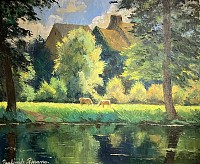BIOGRAPHY

Paul-émile Pissarro, Camille Pissarro's youngest son, was born in Eragny in 1884. He was brought up in the artistic environment of the family home there, and, encouraged by his father, began drawing at an early age. Paul-émile’s godfather was Claude Monet, who became his teacher and close friend, particularly after Camille’s death in 1903. In 1905, Paul-émile exhibited at the Salon des Indépendants for the first time, showing an Impressionist landscape entitled Bords de l’Epte à Eragny. Although his father had supported his desire to be an artist, his mother was eager for him to learn a more practical trade. In 1908, Paul-émile put aside his artistic pursuits to work as an automobile mechanic and test-driver, then as a lace and textile designer, allowing him only a little time to paint. Yet by the 1920s, Paul-émile had become an established Post-Impressionist artist in his own right, sharing a studio with Kees Van Dongen and spending the summer months escaping from Paris with him and Maurice de Vlaminck. In 1924, Paul-émile moved to Lyons-la-Foret, a small town near Eragny. Here Paul-émile reached the peak of his artistic development, arriving at the individual style for which he is best known. In 1930, he visited an area called Swiss Normandy and instantly fell in love with this part of the Calvados region, especially the River Orne that runs through the valley adjacent to the villages of Clécy and le Vey. Paul-émile moved in 1935 with his second wife, Yvonne Beaupel, to Clécy, where he would remain until his death. In 1967, Paul-émile had his first one-man show in the United States at Wally Findlay Galleries in New York. This led to widespread recognition during the later years of his life.
